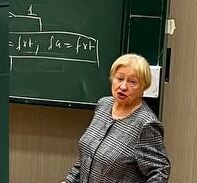ВКР - Математическая модель задержек поездов (1222229), страница 9
Текст из файла (страница 9)
________________
Консультант кафедры «Иностранные языки и межкультурная коммуникация»
И.о. заведующей кафедрой,
ст. преподаватель _______________________ Е.Л. Рябкова
________________
1 Mathematical model of train delays
1.1 Introduction. Description of models. The main results
The first model. Trains move one after another, along the same path in one direction from station A to station B with the same average speed: ahead train 1, behind him, in order, trains 2, 3, etc. We assume that the total number of trains equals n. Distance from train j to train (j – 1) is denoted by , where j = 2, 3, … , n,
, where j = 2, 3, … , n,  is the least safe distance between trains, X2, X3, … , Xn are random variables (while without any assumptions with respect to their distributions). Trains have the same destination station.
is the least safe distance between trains, X2, X3, … , Xn are random variables (while without any assumptions with respect to their distributions). Trains have the same destination station.
We also denote  ,
,  , where v0 is an average speed. Suppose that the train 1 departs from the station A at time t = 0. Then the departure time
, where v0 is an average speed. Suppose that the train 1 departs from the station A at time t = 0. Then the departure time  of the train m can be written as (see Figure 1.1)
of the train m can be written as (see Figure 1.1)
 . (1.1)
. (1.1)
Figure 1.1 – Scheduled departure times of trains 1, 2 and 3 from station A
Suppose that the train 1 unplanned stopped at some time point. Let the train 1 is delayed by the random time  . If the time interval
. If the time interval  is large enough, then the subsequent trains suffer from secondary delays. Assume that train stops, if the distance between the train and preceding (already standing) train was reduced to s0. In this situation we assume that as soon as the preceding train starts moving, then the following train will start moving immediately. Denote by
is large enough, then the subsequent trains suffer from secondary delays. Assume that train stops, if the distance between the train and preceding (already standing) train was reduced to s0. In this situation we assume that as soon as the preceding train starts moving, then the following train will start moving immediately. Denote by  the time interval between the arrivals of trains with numbers (k – 1) and k at the station B for
the time interval between the arrivals of trains with numbers (k – 1) and k at the station B for  . Note that the time interval
. Note that the time interval  has a random length. It is required to determine distribution function
has a random length. It is required to determine distribution function

of the random variable  .
.
The second model. For simplicity, we formulate the problem in an alternative form. Let trains 1, 2, … , n are in the way one after another according to their numbers. Trains depart from the station A at time points  (see Figure 1.1). Consider the sequence of n trains at some point in time
(see Figure 1.1). Consider the sequence of n trains at some point in time  .
.
If the flow of trains moves in the normal mode (without unscheduled delays), we can assume that the intervals between trains will be the same as at the beginning of their movement from the station A, i.e. distance from the train k to the train (k – 1) is equal to  , namely the time interval between trains equals
, namely the time interval between trains equals  . We are interested in what will be with the time intervals between trains, if at the time
. We are interested in what will be with the time intervals between trains, if at the time  train 1 due to some unforeseen circumstances stopped and was detained for a while
train 1 due to some unforeseen circumstances stopped and was detained for a while  ? In other words, it is needed to find the probability distribution of the time intervals
? In other words, it is needed to find the probability distribution of the time intervals  , between trains, provided that train 1 had been detained. This problem is equivalent to the following.
, between trains, provided that train 1 had been detained. This problem is equivalent to the following.
Let the train 1 was delayed at the station A at time t = 0 for a random time  . If
. If  , then trains 2, 3, etc. depart at scheduled points in time
, then trains 2, 3, etc. depart at scheduled points in time  , etc., respectively. If
, etc., respectively. If  , then the train 2 be delayed and starts moving at the moment
, then the train 2 be delayed and starts moving at the moment  . Train 3 departs by the same rule, depending on the delay time of the train 2. Etc. Now
. Train 3 departs by the same rule, depending on the delay time of the train 2. Etc. Now  is the time interval between the departure times of trains with the numbers (k – 1) and k. It is required to determine the distribution functions
is the time interval between the departure times of trains with the numbers (k – 1) and k. It is required to determine the distribution functions  of the random variables
of the random variables  .
.
An example. If n = 5, Tk = 2, k =  , t0 = 1, then departure times of trains satisfy the equalities T(k) = 3(k – 1), k =
, t0 = 1, then departure times of trains satisfy the equalities T(k) = 3(k – 1), k =  . Figure 1.2 shows intervals
. Figure 1.2 shows intervals  , k =
, k =  , depending on the six values of the interval
, depending on the six values of the interval  .
.
Figure 1.2 – The time intervals  for some
for some 
In Figure 1.2 the dots indicate the actual departure times of trains that appeared as a result of delay of the train 1 for a time  .
.
Let us remind the basic assumptions:
only the train 1 undergoes the primary delay  ,
,
 .
.
By the symbol R(k), in contrast to the T(k), we denote the real departure time of the train under the number k.
Order of the train departures. Let  be a fixed integer.
be a fixed integer.
1. If
 , (1.2)
, (1.2)
then
 . (1.3)
. (1.3)
2. If
 , (1.4)
, (1.4)
then
 . (1.5)
. (1.5)
Next, we shall use the following notation

where A is an arbitrary set on the real line R.
Assume that the total number of trains equals  . Let
. Let  for k > n.
for k > n.
Theorem 1. 1. If  , then
, then
 .
.
2. Let k be a fixed integer,  . If
. If
 , (1.6)
, (1.6)
then
 . (1.7)
. (1.7)
3. If
 (1.8)
(1.8)
then
 (1.9)
(1.9)
 (1.10)
(1.10)
Theorem 2. Let  . The following formulas hold
. The following formulas hold
 (1.11)
(1.11)
 (1.12)
(1.12)
 .
.
Let us define
 (1.13)
(1.13)
Then, in the right-hand side of eqn (1.12) for k = 2 we have

Therefore, the formula (1.12) coincides with formula (1.11) for k = 2. Thus, Corollary 1 holds.
Corollary 1. The formula (1.12) holds for  .
.
Let us formulate corollaries of Theorem 2 in terms of given probability density functions.
Corollary 2. Let all  be constants which are not necessarily equal to each other,
be constants which are not necessarily equal to each other,  is the density function of the random variable
is the density function of the random variable  . Then, the following formula holds
. Then, the following formula holds
 (1.14)
(1.14)
 , in particular,
, in particular,  .
.
Corollary 3. Let all  be constants which are equal to the same number T,
be constants which are equal to the same number T,  is the density function of the random variable
is the density function of the random variable  . Then, the following formula holds
. Then, the following formula holds
 (1.15)
(1.15)
 , in particular,
, in particular,
 (1.16)
(1.16)
Recall the definition of the convolution of the density functions. If  and
and  are two arbitrary probability density functions, the convolution of these densities is the integral
are two arbitrary probability density functions, the convolution of these densities is the integral  which is denoted by
which is denoted by  . It is known that the operation of convolution is commutative. If
. It is known that the operation of convolution is commutative. If  we shall use the notation
we shall use the notation
 .
.
By definition, we assume that  . Recall also that if independent random variables are absolutely continuous, then the density function of their sum is equal to the convolution of the original densities.
. Recall also that if independent random variables are absolutely continuous, then the density function of their sum is equal to the convolution of the original densities.
Corollary 4. Let  be independent identically distributed random variables with the density function
be independent identically distributed random variables with the density function  . Let
. Let  has a density function
has a density function  and be independent of
and be independent of  . Then,
. Then,
 (1.17)
(1.17)
 (1.18)
(1.18)
Remark 1. Since random variables under consideration are positive, then in integrals of Corollary 4 lower limit of integration  can be replaced by 0.
can be replaced by 0.
Remark 2. We define 0-fold convolution as a generalized function with the following property: for any bounded continuous function  the equality
the equality  holds. Then eqn (1.18) for k = 2 coincides with (1.17).
holds. Then eqn (1.18) for k = 2 coincides with (1.17).
We denote by N the number of secondary delays (in the framework of this model).
Lemma 1. For each fixed integer  we have
we have
 (1.19)
(1.19)
We now give two corollaries arising from this lemma.
Corollary 5. If  is a constant value, then
is a constant value, then
 .
.
Corollary 6. If  are independent identically distributed random variables with the density function
are independent identically distributed random variables with the density function  , then
, then
 .
.
Observe that the problems associated with the delays of trains were considered in many papers (see e.g. [2]). However, in these papers the problem statements and methods differ from ours.
1.2 Proof of Theorem 1
In order to prove Theorem 1, we reformulate it in terms of  and
and  .
.
Theorem  . 1. If
. 1. If
 (1.20)
(1.20)
then
 . (1.21)
. (1.21)
2. Let k be a fixed integer,  . If
. If
 (1.22)
(1.22)
then
 (1.23)
(1.23)
and hence (1.7).
3. If
 (1.24)
(1.24)
then
 (1.25)
(1.25)
 . (1.26)
. (1.26)
Lemma 2. Let  be a fixed integer.
be a fixed integer.
1. Inequality (1.22) entails (1.23).
2. Double inequality (1.24) entails equality  .
.
Proof. 1. Our proof will be done by mathematical induction. It is easy to verify the validity of the first statement for k = 2. The inductive assumption is based on the following logical consequence: if

for some fixed integer  then
then

Let condition (1.22) is valid. Then,
 (1.27)
(1.27)
Because of inductive assumption, we get

Next, we obtain by using the first estimate in (1.27) the inequality (1.4), which
involves (1.5). Thus,

2. Let  , then
, then  . Otherwise, due to (1.2), (1.3) we have
. Otherwise, due to (1.2), (1.3) we have  . Now, by using (1.4) and (1.5), we obtain
. Now, by using (1.4) and (1.5), we obtain  . Because of (1.23) then
. Because of (1.23) then  . This is contrary to the right hand side of inequality (1.24). Thereby
. This is contrary to the right hand side of inequality (1.24). Thereby  .
.
Proof of Theorem  . 1. Note that
. 1. Note that  . Therefore the condition (1.20)
. Therefore the condition (1.20)
coincides with (1.2), which entails equality  and, consequently, (1.21).
and, consequently, (1.21).
2. By Lemma 2 the condition (1.22) involves (1.23) and, consequently, (1.7).
Formula (1.25) is a consequence of Lemma 2, namely:

Since  , then
, then  for
for  . This implies (1.26).
. This implies (1.26).
Thus our theorem is completely proved.
1.3 Proof of Theorem 2
Lemma 3. The formula (1.11) holds.


















